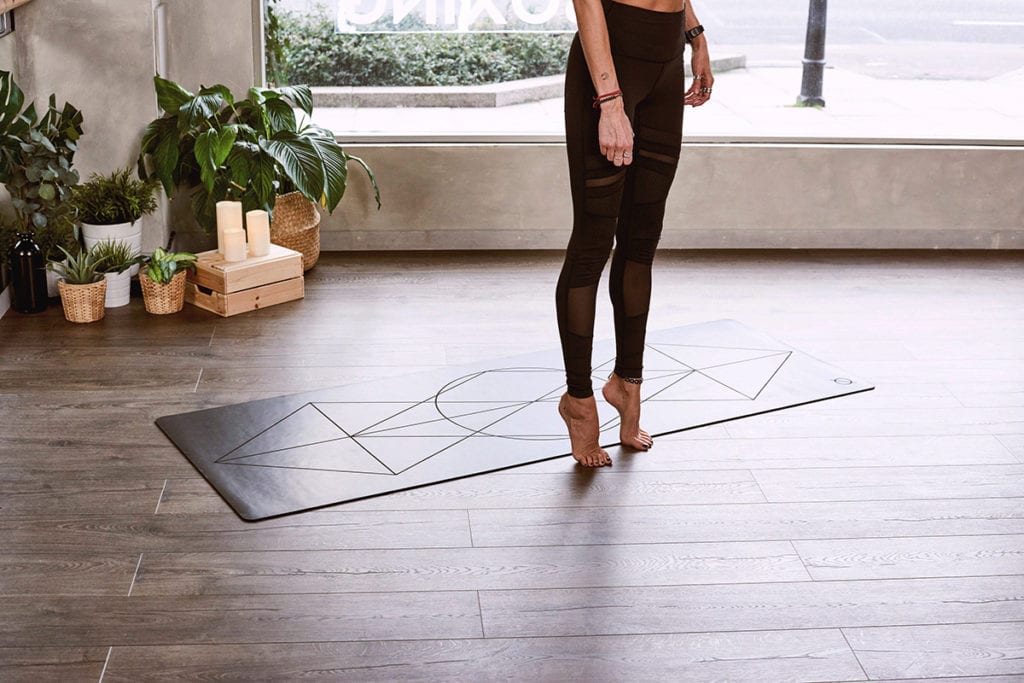What to Know About Working Out Barefoot
You’ve already made it down to the basement—er, “the gym”—before you realize you left your shoes upstairs. Maybe you read Born to Run however many years ago and you’ve always wanted to try barefoot running. Or, you could be trying to keep germs on the outside of your house by not wearing them indoors. You might just be enjoying not being confined in your tightly-laced athletic trainers.

Whatever the reason, working out barefoot is more prevalent than ever right now, as more people work out at home and not in boutique studios that require shoes.
“This pandemic has seen everyone change their routine and lifestyle in many different ways,” explains Ilaria Cavagna, Pilates instructor and founder of FEET-NESS™. “With the more sedentary life that we are all forced to follow, finding the space and time to workout in the house is very important and very beneficial.”
And, she continues, working out barefoot can lead to a whole chain of benefits that travel up your body.
“The fact that we work out barefoot is actually a very good thing,” she says. “The feet are our roots, our foundation. By stimulating the nerves of the feet thanks to a direct contact with the floor, we are improving foot health, foot strength and posture.”
What are the advantages of barefoot training?
The advantages of working out barefoot can be boiled down to a few simple reasons: improving your proprioception (or your sense of how you move in the world), increasing muscle recruitment, and producing more force when you lift weights.
“There are a lot of sensory endings in the palms and bottom of the feet that tell the brain how to control and position the joints. As babies, that’s part of how we developed motor control,” shares Doug Barsanti, owner of ReInvention Fitness LLC. “Shoes deaden a lot of that sensory info so training barefoot has great benefits in terms of establishing better body control and mechanics.”
Ridge Davis, celebrity trainer and Master Instructor at The WALL in Los Angeles, agrees, adding “Working out barefoot creates stability for your ankle joint. This allows the stabilizer muscles around your foot to be more engaged which leads to stronger movements. Also, when the ankle is more stable, it leads to better stability in your knee and hip joints.”
Dr. Nicole Lombardo, a physical therapist and CrossFit Level 1 coach, explains “Without shoes, our feet and ankles are gripping, absorbing shock and stabilizing our body without the help, cushion or restriction a shoe provides. This can build strength in our feet, ankles and calves, but should be done with caution.”
What kind of exercises can be done barefoot?
The experts suggest starting small, with low-impact workouts.
“Yoga, Pilates, and barre workouts are all simple and great workouts to execute barefoot!” says Cavagna.
Beyond that, try easing into your usual rotation of functional movements, like squats, lunges, push-ups, and planks (and if you have a history of foot problems, you might want to take it even slower).
“Try shorter duration workouts- 15-20 minutes to start- and see how you feel,” recommends Dr. Lombardo. “You might be sore as different muscles are working to move and stabilize your body. Slowly increase the duration of your workouts if you don’t feel any pain.”
Experienced lifters can try doing their lifts barefoot, but take caution when using free weights or kettlebells. If that weight happens to fall on your foot, you have a much higher risk for an injury or a broken bone.
Davis explains more about the advantages of lifting while barefoot.
“When barefoot, you have a heightened awareness of the weight distribution in your feet,” he says. “Shoes have a tendency to shift our weight to unnatural areas of our feet. When performing lower body exercises like squats, deadlifts, and lunges, it is crucial to be able to shift your weight into your heels in order to fully engage the posterior chain of the body (glutes, hamstrings, and lower back muscles). Having a better gauge of your foot’s weight distribution enhances overall performance in your workouts as well.”
What workouts should not be done barefoot?
Lace up your sneakers if you’re tackling a plyometric workout that’s heavy on jumping, experts advise.
“These are movements that are high impact on the lower body and require jumping. Everyone has different levels of cushioning on the bottom of their feet. But doing plyometric movements consistently without proper support can lead to plantar fasciitis,” Davis said.
Cavagna elaborates, “If you are not used to executing jumps barefoot, it could be challenging for the technique and also too intense on the joints.”
“Some people can handle higher-impact workouts barefoot but it may depend on the surface (carpet is easier on the feet than hardwood floors or concrete), any previous injuries to their feet or ankles, and their level of comfort (meaning their feet shouldn’t hurt training barefoot),” Barsanti adds.
If you’re taking your workout outside, make sure you’ve combed the area for anything that could hurt the soles of your feet, like glass, sticks, or burrs. You can always lay down a towel for an extra layer of protection.
And take caution with socks (unless they’re the grippy kind used in Pilates or barre classes); socks may slide on hardwood or carpet, putting you at risk for injury. Take a few practice moves before getting into your workout to test the cushion and the grip of your feet on the floor.












